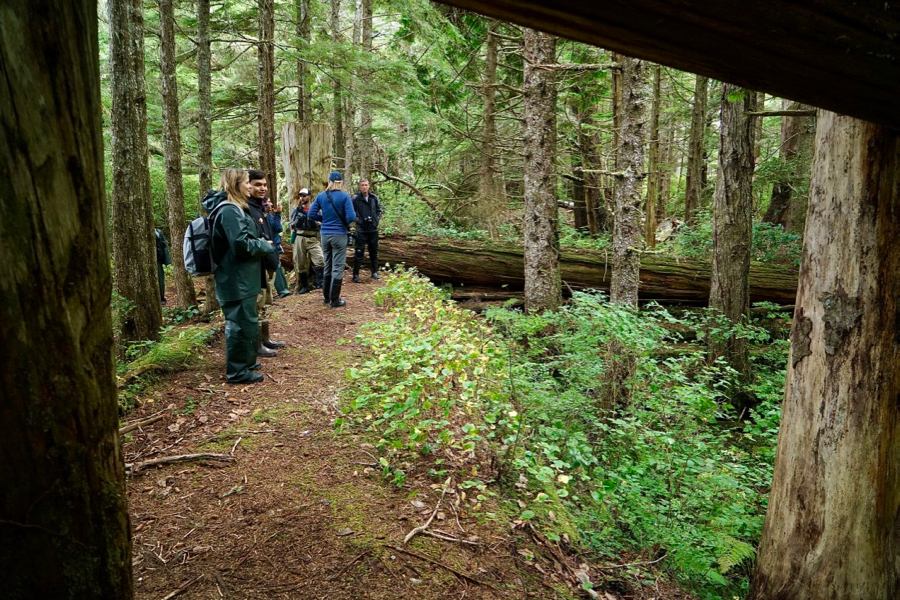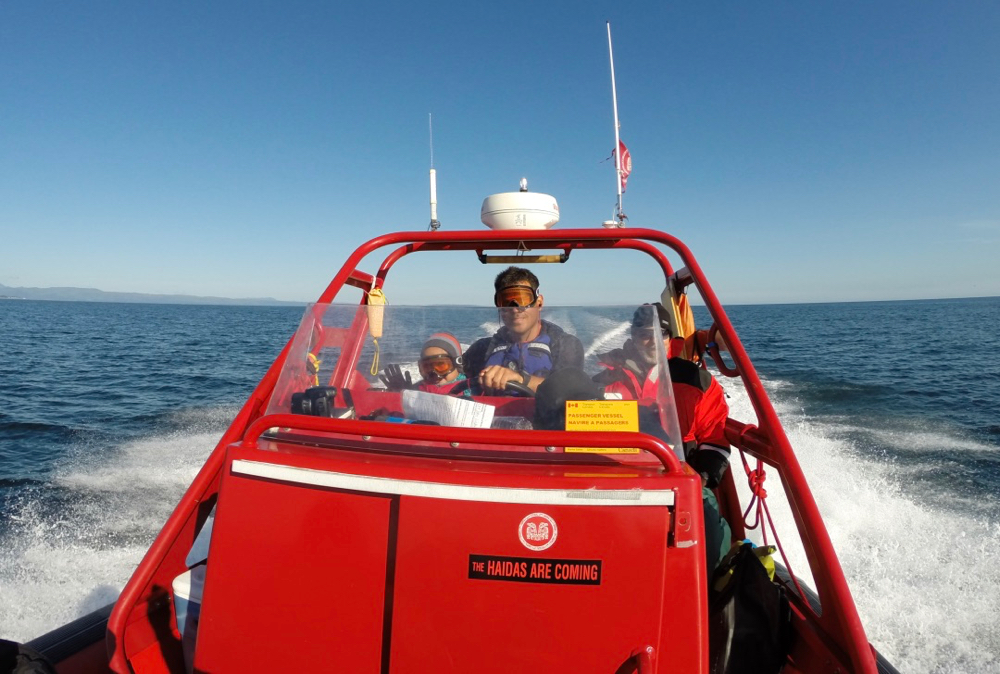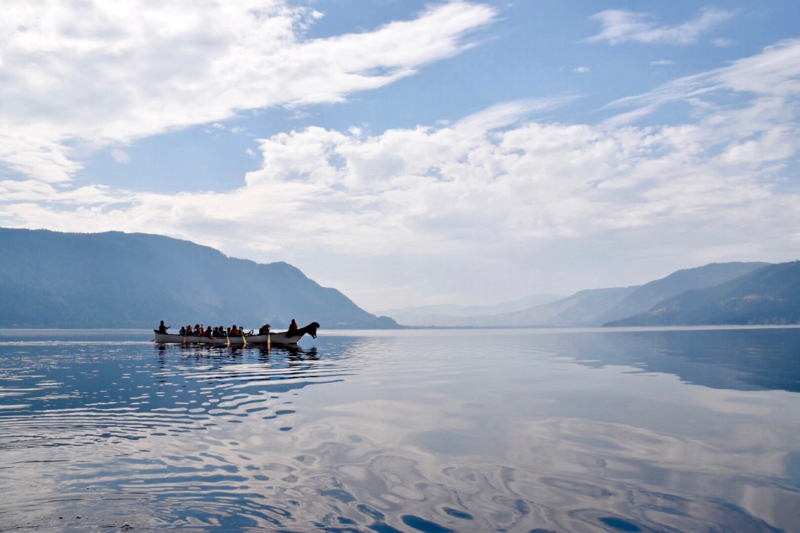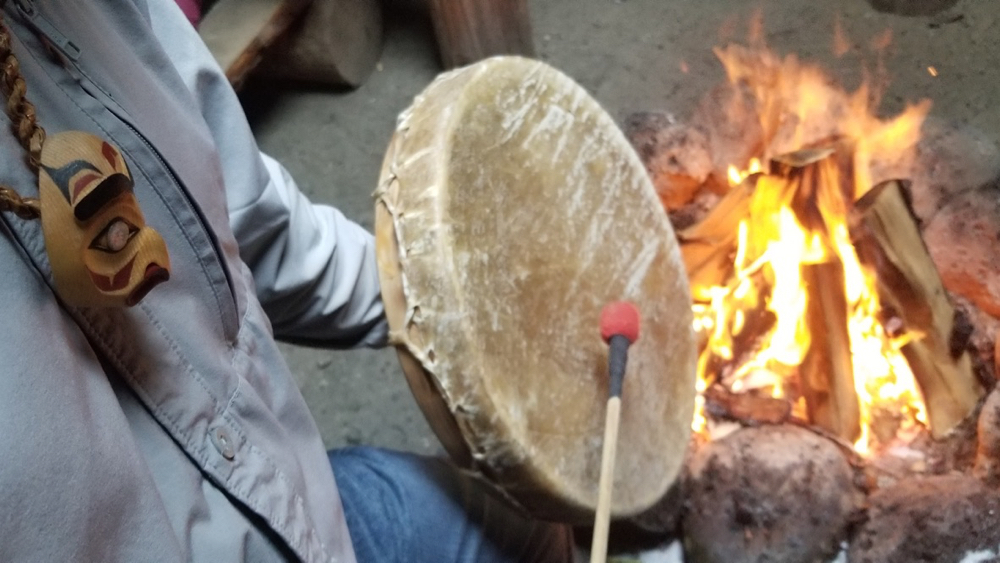Editor’s note: This story is the result of an arms length collaboration with the Indigenous Tourism Association of British Columbia (ITBC) — an excellent resource for information about Indigenous tourism opportunities in the province. Our post was not reviewed or edited by our partners in tourism before publication.
— By Kim Gray
We’re a small group of four: myself, my daughter, a thoughtful young man visiting Vancouver from Morocco, and our guide, Candace Campo of Talaysay Tours, who is leading us through the city’s cherished Stanley Park as part of a 90-minute “Talking Trees” experience. The day is wet, but we don’t mind. After all, we’re in temperate rainforest country and we’re mostly protected by a canopy of towering trees.
As we wander through the urban forest, Campo, a natural born storyteller from the shíshálh (Sechelt) Nation, shares fascinating stories of ancient and living Indigenous connections to trees. “We are the land, and the land is us,” explains our guide, while pointing out uses of Western Alder (burned wet to smoke salmon, making the fish taste so good “you’ll never want it any other way”), Western Hemlock (its branches once used as bath towels) and Red and Yellow Cedar (sourced historically for shelter, dug-out canoes, clothes and tools and revered, even today, as trees of life.)
The pace of our forest education is slow and deliberate. In what Campo calls a “touch the tiny” exercise (which brings to mind the art of Japanese forest bathing only with an Indigenous lens), we’re encouraged to absorb the details of the natural world around us. A shiny droplet of water perched on a leaf. A sprig of emerald-green moss. The lines etched on a small section of bark.
We’re grateful to spend time with someone whose people have existed on the Northwest Coast for millennia. And Campo? She’s happy because she gets to share her culture for a living. “Sometimes, I pinch myself. I’ve always had an understanding that I would work on behalf of my people, because that’s how we’re raised,” she says. “Now I’m actually doing it. We have stories to share, the stories of our ancestors. When these stories pass through us, they enrich our lives and strengthen our spirits.”
As a travel writer with a special interest in Canada, I’ve been watching and frequently writing about what is essentially an Indigenous tourism boom happening right now across the country. It’s an exciting time, and from what I’ve observed, the resulting ripple effect — transforming lives, strengthening communities, economies and cultures, directly and indirectly healing the nation and even impacting the planet in a positive way — seems like a win-win for everyone.

Humpback whale watching with Spirit Bear Lodge / Photo by Jennifer Twyman
Not long ago, I had an extraordinary experience with photographer and Toque & Canoe co-founder Jennifer Twyman at Spirit Bear Lodge, owned by the Kitasoo Xai’xais First Nations community and located near Klemtu on the central B.C. coast.
The moment we arrived at the remote lodge after travelling from Calgary, Twyman announced that she felt an immediate sense of calm. After four days of adventures that took us through a region that is so wildlife-rich it’s been called Canada’s Galapagos (check out our bellyflopping spirit bear video here), she noticed that all of her city-life stress had fallen away.
“Coming here for many visitors is transformative. Their heart rate can actually drop,” says John Czornobaj, who works as the lodge’s general manager. “People draw strength from their experiences with us. They often cry when they leave, because they know they’re leaving something really special.”
Award-winning Canadian poet Lorna Crozier had a similar epiphany when she visited Spirit Bear Lodge five years ago, and it eventually led to the publication of her best-selling book of conservation poetry, The Wild in You, created in collaboration with photographer Ian McAllister. (Stay tuned for McAllister’s soon-to-be-released IMAX film Great Bear Rainforest, featuring this extraordinary region.)
Crozier still has a strong recollection of her experience with Indigenous tourism: “I’d never been so close to bears, humpback whales, orcas, eagles and streams of spawning salmon. The guides, boat captains and the young people from the village who were learning to be cultural ambassadors, delighted in showing visitors like me the natural wonders of their traditional territory. Their stories, their love of a place they’ve called home for thousands of years, filled my heart and soul.”

Writer with cultural guide Troy Reece / Spirit Bear Lodge / Photo by Jennifer Twyman
No question, Indigenous-led tourism provides opportunities for non-Indigenous visitors to comfortably meet and engage with communities they might not otherwise connect with.
“Communities whose cultures are unique in the world. Everyone has so much to gain. And anyone who knows Canada’s history, knows there is a dark past with respect to the treatment of Indigenous people,” says Czornobaj. “For this country to heal, awareness among non-Indigenous Canadians is critical, as opposed to continuing to be willfully ignorant.”
Beyond life-changing guest experiences and windows for education and reconciliation, Czornobaj points to the employment, pride of culture and overall economic benefits that Spirit Bear Lodge has brought to the Kitasoo Xai’xais community, not to mention the operation’s eco-friendly nature.
“Until now, many primary economies have been based exclusively on extraction of natural resources,” says Czornoboj. “Indigenous tourism can provide sustainable alternatives for making a living.”
What’s more, he says, after intimate “experience-of-a-lifetime” encounters with wildlife, visitors are likely to return to their homes throughout Canada and beyond caring more deeply about the plight of the natural world.

Spirit Bear in Great Bear Rainforest / Spirit Bear Lodge / Photo by Jennifer Twyman
James Cowpar of Haida Style Expeditions says there was a day when a world-class fishing trip to Haida Gwaii meant flying into and out of a remote lodge with no contact with local people. Today, thanks to the development of Indigenous tourism, Cowpar, a member of Haida Gwaii’s Tsaahl Eagle Clan, says travellers to this remote and beautiful archipelago have more options.

Photo courtesy Haida Style Expeditions
“We want to provide local context. Haida Style is community-based tourism. What does that mean? Dollars spent on us are also spent on the berry pickers who pick berries for our salads,” says Cowpar, who runs Haida Style Expeditions with his twin brother.
“We don’t have a scripted approach. We’re not selling, we’re sharing our culture. We may take you to an ancient village site, but you’re going to meet someone who has lineage from that site. You’re going to visit our traditional fishing spots. You’re going to learn about the significance of wild salmon. And we will treat you like family. Chances are, you’re going to want to come back and visit us again.”

Photo by Niki with Moccasin Trails / Thomspon Okanagan Tourism Association
Likewise, Frank Antoine, co-owner (with Greg Hopf) of Moccasin Trails in B.C.’s interior, feels grateful to be running a business that not only inspires the youth of his community to embrace their culture, but also connects living Indigenous communities to Canadian and international guests.
Antoine, who takes people paddling on the traditional canoe routes of the Secwepemc Nation (Shuswap) Nation, helped establish an award-winning cultural program during his years as an employee of the Indigenous-owned Quaaout Lodge & Spa at Talking Rock Golf Course, located near Chase, B.C.
Travellers at home and abroad, he says, are demonstrating interest in going beyond stereotypical Canadian tourism experiences.
“They want to see more of the beauty of the country, combined with an Indigenous experience,” says Antoine. “In the end, visitors seem to appreciate how genuine our approach is. It’s not all about song and dance. It’s about how we exist today, as a people.”

Photo courtesy Quaaout Lodge & Spa
As Indigenous tourism continues to take hold around the country, I can say confidently that it’s enriching my own sense of Canada. I’m grateful for people like Campo — whose ancestral name is “xets’emits’a” meaning “to always be there” — who have the desire to share their stories.
Since my time with Talaysay Tours, I’ve been encouraging other people I know to seek Campo out. I know they won’t be disappointed. “I see the forest as a living, highly functioning, spiritual ecosystem,” says Campo. “The forest is one of the things we need the most for our own health and wellness. We all have Indigenous roots at some point in our ancestry. We all stand to benefit from nature.”
She’s convinced that people everywhere are starving for connection to the land, and to each other.
Perhaps this is yet another benefit of making Indigenous tourism part of our lives — the promise of new friends and allies in a country and on a planet that could use now, more than ever, a little extra love and understanding.

Talaysay Tours, Stanley Park / Photo by Toque & Canoe
Founded by two Canucks on the loose in a big country, Toque & Canoe is an award-winning Canadian travel blog. Follow our adventures on Twitter, Instagram and Facebook


Linda Heinrich commented:
Oh my, I thoroughly enjoyed this wonderful article. It reminded me of how lucky my sister and I were to grow up in Prince Rupert within a few minutes walk to the rainforest where we played – building shacks, observing the fungi, graceful ferns, beautiful (yes. beautiful) skunk cabbages, eating salmon berries, joining salal leaves together with little twigs to make imaginative headbands. (We called them crowns.) I am only now becoming aware that Indigenous peoples used some of these plants in other ways – medicinal as well as edible. And then there was the pond – Moresby Pond, within five minutes – we skated there, hunted for salamanders, built rafts. Those were the carefree days when you went out to play and your parents said “see you at dinner”.